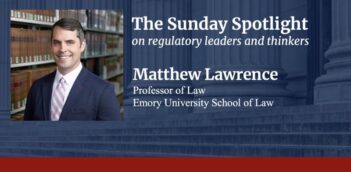
Scholar explains why the DEA—not FDA—has power over the classification of potentially addictive substances.
The U.S. government has declared a response to the opioid crisis that prioritizes rehabilitation and treatment. Specific priorities include improving access to prevention services, strengthening public health data, and supporting research on addiction and pain. Despite this declaration, the federal agency with primary control over potentially addictive substances is not centered on public health, but on law enforcement.
That regulatory power should change, argues Taleed El-Sabawi, a professor at Elon University School of Law. Instead of the U.S. Drug Enforcement Administration (DEA) having authority to regulate potentially addictive substances, the U.S. Food and Drug Administration (FDA) should be given that authority. The approach that FDA would take would better address the nation’s ongoing opioid crisis.
In response to the opioid epidemic, the U.S. Congress passed the Comprehensive Addiction and Recovery Act of 2016. This law states that the opioid crisis should be addressed with an emphasis on prevention, treatment, and recovery.
Notwithstanding the government’s intent to treat substance abuse as a national health concern, the DEA continues to hold “key” decision-making power on the classification of potentially addictive substances. The DEA has the power to schedule a substance, placing certain restrictions on its use and imposing criminal penalties for those who fail to comply with the restrictions.
Although the DEA must refer to FDA recommendations on drug scheduling, the split enforcement between the two agencies leans more toward the law enforcement approach of the DEA, El-Sabawi asserts. For example, FDA will often defer to the scheduling preferences of the DEA on a substance that has yet to be classified.
Why does the DEA hold such power? The common reason, explains El-Sabawi, hinges on alleged failures of the Bureau of Drug Abuse Control (BDAC), a short-lived office within FDA that was once responsible for drug enforcement. According to El-Sabawi, some scholars attribute the downfall of the BDAC to poor performance and its regulatory approach to enforcement. She explains that, because of such asserted failures, these scholars think FDA was not equipped to handle regulatory control of potentially addictive substances.
But El-Sabawi argues that the demise of the BDAC was not due to “poor performance.” Instead, the disbanding of this office was largely due to the influence and infiltration of the Federal Bureau of Narcotics, an entity specific to narcotics that served as a precursor to the DEA. Once the BDAC dissolved, FDA lost its status as the primary enforcement agency governing potentially addictive substances.
Using accounts of former FDA officials, El-Sabawi details the clash between FDA and employees at the Federal Bureau of Narcotics. Early on, the Narcotics Bureau defined its function as a police entity. In the mid-1960s, former Narcotics Bureau officials joined the BDAC to help FDA with its investigatory role. However, El-Sabawi uncovers that those former Narcotics Bureau employees were transferred to the BDAC because they were under investigation for corruption. She notes that at the BDAC, former Narcotics Bureau officers used a punitive approach and were known to take “ethically questionable shortcuts.”
Frustrated with the new tone of the Narcotics Bureau, FDA employees transferred out of the BDAC, and the entity quickly dissolved. Soon after, President Richard M. Nixon created the DEA and “endorsed and institutionalized the Narcotics Bureau’s criminal justice approach over FDA’s regulatory, health-oriented approach,” El-Sabawi writes.
Indeed, the DEA and FDA have distinct ways of regulating potentially addictive substances. El-Sabawi argues that the differences between the agencies matter.
The DEA bases many of its scheduling decisions on the characteristics of a drug’s active ingredients, rather than on risks and benefits to the user. In contrast, FDA has a more nuanced approach because it considers dosage and product formulation, factors that lead to potential addictiveness. Such scheduling decisions affect the manufacturing, distribution, and availability of substances.
Moreover, the agencies differ in their purpose and line of action. The DEA, a subset of the U.S. Department of Justice, is centered on punitive measures. FDA, which is within the U.S. Department of Health and Human Services, is focused on public health and drug safety. El-Sabawi argues that the function of the DEA—to prosecute drug dealers and persons addicted to drugs—may encourage the agency to label substances at a higher scheduling classification.
A regulatory transfer to FDA would bring medical considerations and scientific accuracy to the forefront of decision-making. More accurate drug classifications, coupled with the health-centered approach of FDA, would benefit people struggling with opioid addiction and potential drug users.
For these reasons, El-Sabawi concludes that putting FDA in charge would be more effective for addressing the nation’s ongoing opioid crisis.



